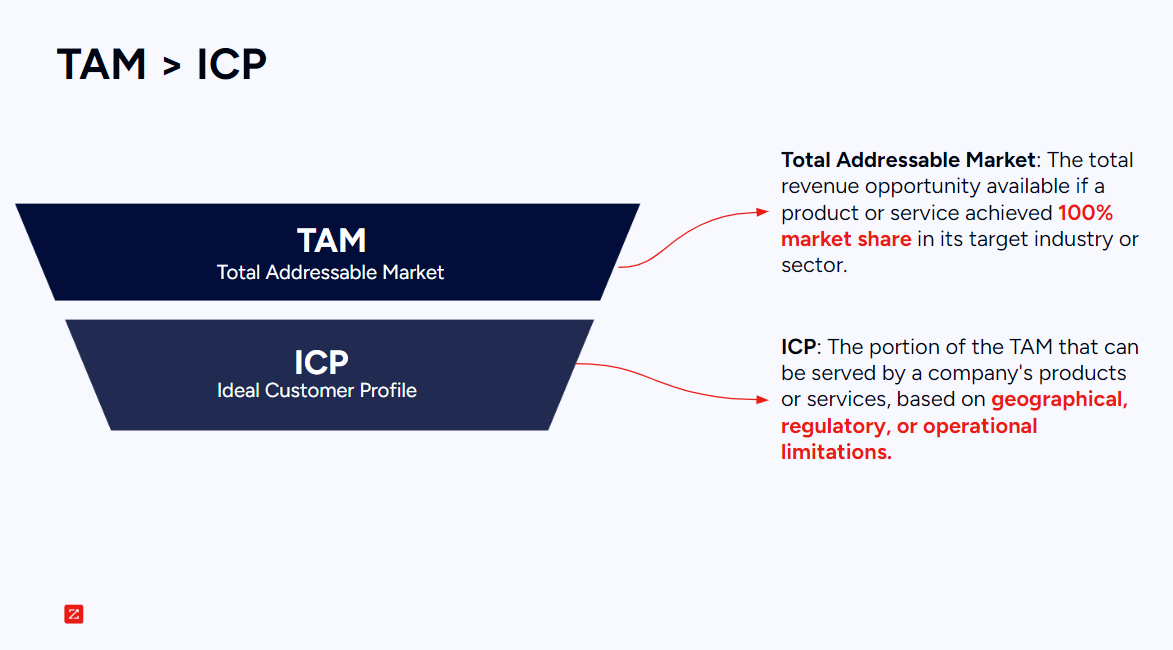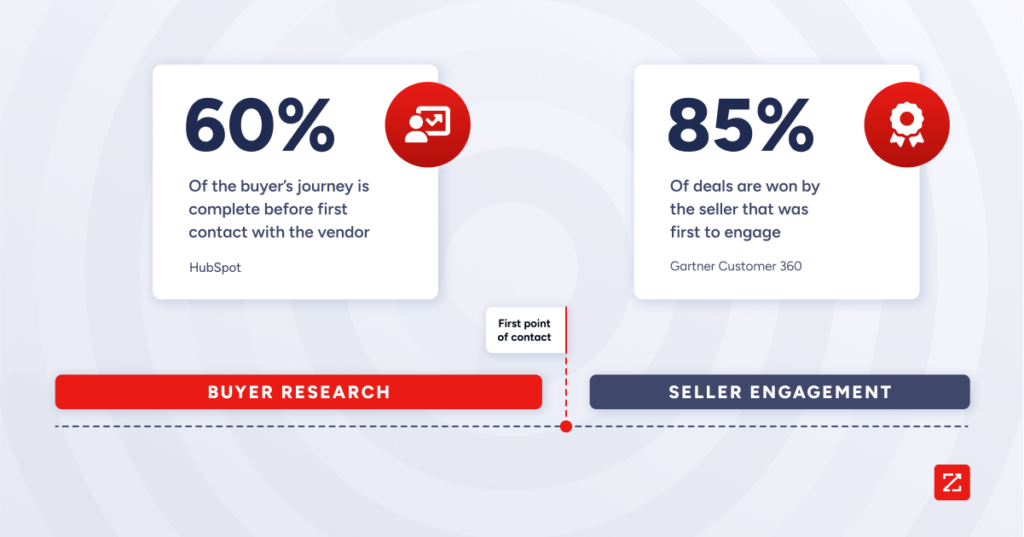Marketing teams of all sizes are eager to drive growth wherever they can find it, from expanding into new markets to driving cross- and upsell opportunities. But moving from inspiration to action is easier said than done.
One major roadblock? Incomplete, inaccurate data that isn’t built to capture the constantly evolving needs of your customers.
Luckily, today’s top marketers are able to assemble a much more accurate view of their customers and prospects by relying on Go-to-Market Intelligence, which fuses high-quality B2B data, real-time buying signals, and AI-fueled insights.
If you’re ready to adopt a more data-driven approach to GTM, start with these seven key steps — and get ready to drive more leads, more opportunities, and more revenue.
1. Define and Validate Your Total Addressable Market (TAM)
How well do you really know your customers?
Many companies believe they keenly understand their ideal customer profile (ICP) and Total Addressable Market (TAM), but even this understanding is often based on incomplete information.
That’s why it’s crucial that GTM leaders don’t just define, but also validate, their TAM and their ICP.

There are two primary methods of calculating TAM: top-down and bottom-up. Of these two methods, bottom-up tends to be more accurate, as it relies on first-party data to estimate revenue and market growth.
For a quick and easy way to gauge your TAM, you can use ZoomInfo’s TAM Calculator.
These simple equations are a great starting point for GTM leaders to calculate their TAM. But what happens if the data used in these calculations changes, such as significant changes in ACV? The output becomes outdated almost instantly.
That’s why GTM Intelligence is vital for marketers: Business simply moves too quickly for CRM data alone to capture the true breadth of opportunity in today’s markets.
2. Pinpoint Key Decision-Makers and Contacts
Think about how often former champions and key decision-makers move to new roles at other companies. It’s no wonder many GTM teams end up wasting time trying to reach decision-makers who have moved on, or reaching out to the wrong contacts entirely.
To complicate matters, today’s buying groups are larger than they’ve ever been — Gartner estimates the average buying group is now between six and 10 people.
The large-scale automation made possible by GTM Intelligence means frontline teams can go beyond individual contacts to profile entire buying groups, including key people who can make or break deals.
Find your key contacts and influencers by:
Mapping out key personas and decision-makers within target accounts
Accessing verified contact data, including direct emails and mobile numbers
Identifying the contacts most likely to engage, based on previous interactions and account activity using AI-powered propensity models
3. Leverage Buying Signals and Intent Data
The buyer’s journey has never really been linear, and it’s getting more complex. Buyers are better-informed than ever before, with many engaging sellers later and later in the process.

Fortunately, this drawn-out buyer research period actually reveals important details about prospects’ needs, concerns, and intentions. And marketers can surface this vital information to gain a critical competitive advantage.
Buying signals, for example, give GTM teams invaluable insight into what prospects want, and provide timely opportunities for targeted outreach. Track these real-time signals and intent activity so you can:
Find out which companies are most likely to convert based on high-velocity buying signals: attending events, downloading content, and active competitor research
Discover the earliest inklings of expansion opportunities at key accounts, including new investment funding, budget increases, and senior leadership changes
Prioritize accounts that match historical patterns of high-value behavior, mapping the characteristics of your team’s previous success onto new opportunities at massive scale
4: Optimize Outreach with Data-Driven Personalization
Today’s business leaders want to see a genuine understanding of their most urgent problems, and timely, relevant offers that can solve those problems. These insights are readily available — just not where most marketers have traditionally looked for them.
They’re buried deep in earnings calls and 10-K filings, discussed in podcast interviews and media appearances. They’re reflected in org chart changes, M&A activity, and major investments.
Dig into these key market narratives to surface deep competitive insights, and leverage them by:
Crafting messaging based on firmographic, behavioral, and intent data insights, including key hiring changes, real-time comparative competitor evaluation, and research into product pricing information
Leveraging competitor intelligence to position your solution as a superior alternative, such as the limitations of new product offerings from other companies in your industry
Using omnichannel engagement strategies (email, LinkedIn, calls, and paid media) to reach decision-makers where they are and increase response rates
5: Find and Engage Past Champions
Satisfied customers moving to new roles creates two opportunities: following your champion to their new job, and cultivating a replacement at their former company.
Speed is essential here, both in congratulating your existing point of contact and building a relationship with your new one.
Leveraging real-time GTM Intelligence solutions makes tracking champion movements much easier — you’re much more likely to be in the driver’s seat than reacting to a bounceback email.
However you track these changes, be prepared to take advantage:
Identify former users or advocates of your product who have moved to target accounts
Engage these past champions to reintroduce your solution and establish new relationships
Analyze org chart data and build automatic outreach to your new points of contact when changes occur
6: Activate Data Across GTM Channels
Siloed data is a persistent headache, causing sales and marketing teams to stumble over KPIs and waste cycles getting aligned on messaging, targeting, and timing.
That’s why it’s critical to seek GTM Intelligence providers that can deliver unified experiences and agent-ready datasets that allow today’s advanced GTM apps to push information to all members of a revenue operation.
Break down data silos by using GTM Intelligence to:
Automate and streamline lead enrichment directly into CRM and marketing automation platforms
Enable sales teams with real-time insights on the best accounts to engage at the right time
Align sales and marketing efforts by delivering hyper-targeted campaigns based on dynamic, up-to-date intelligence
Use AI-driven recommendations to surface the highest-priority accounts and optimize outreach strategies
7: Measure, Iterate, and Scale
The bedrock of successful GTM strategies is constant analysis and refinement.
In the past, marketers were more likely to focus primarily on quantity, driven by a general tide of market expansion and sales motions built to optimize for capacity. Today, as ZoomInfo Senior Vice President of Marketing Carl Koussan-Price notes, the focus has shifted to quality.
“Instead of flooding inboxes with generic outreach, start by focusing on identifying key accounts based on intent and behavioral signals,” Koussan-Price says. “Then engage these buyers earlier in their journey, before they officially enter a buying cycle. And make sure you’re customizing messaging based on where an account is in their decision-making process.”
While conventional metrics such as conversion rates and deal velocity still have their place, marketers should also identify and examine the behavior of top-performing accounts, such as:
What were your best-fit customers doing six months before they bought?
Were they increasing job postings in key departments?
Were they adopting new technologies?
Were they consuming specific types of content?
Unlock Your Market Potential with GTM Intelligence
Growth doesn’t come from guesswork. It comes from knowing exactly where to focus your efforts, who to engage, and when to act. That’s the power of Go-to-Market Intelligence — it gives marketing teams the confidence to move faster, engage smarter, and scale revenue with precision.
ZoomInfo delivers the data foundation and signal-driven insights to unlock untapped markets, streamline campaign execution, and fuel measurable growth. If you’re ready to turn better intelligence into bigger impact, talk to a ZoomInfo data specialist today.


